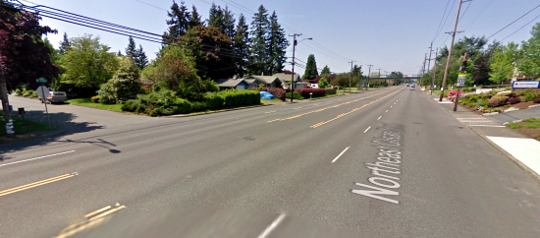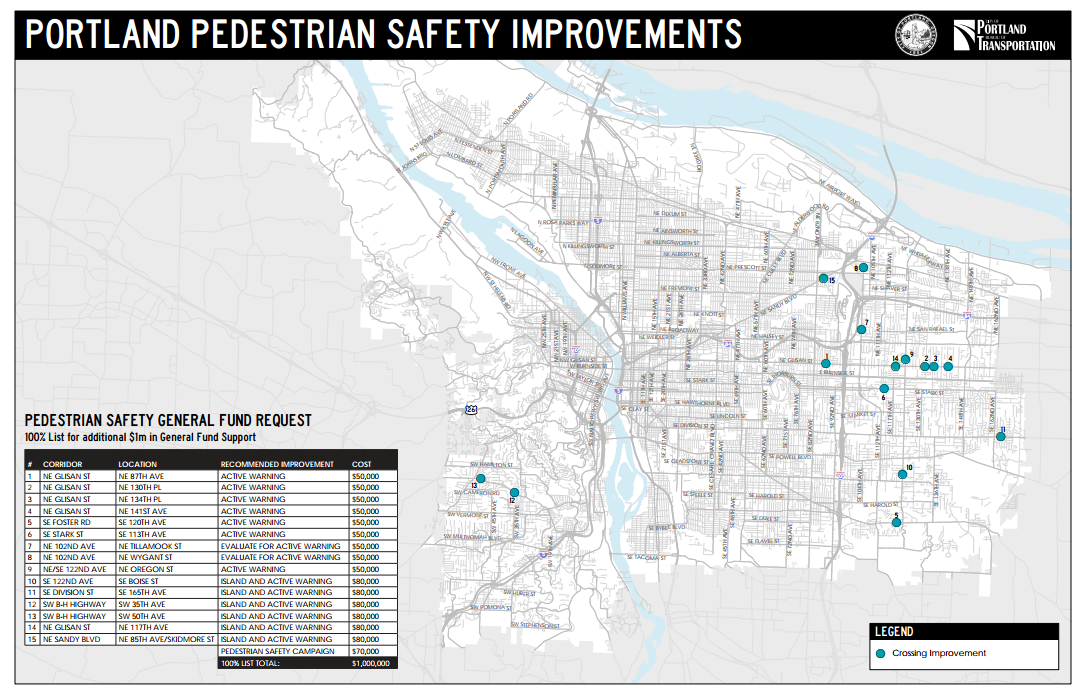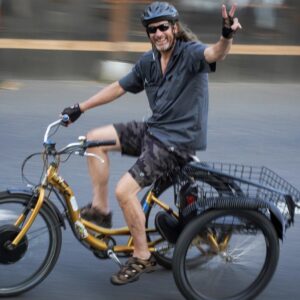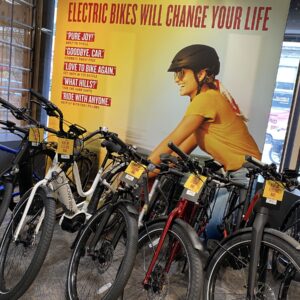The City of Portland’s general fund has a few million dollars to spare, and Commissioner Steve Novick is mounting an unusual campaign to spend some of it on safer street crossings.
In a city where you’re twice as likely to die from traffic as from homicide, Novick and other backers say making roads safer is the most cost-effective way to improve public safety.
In an interview Friday, Novick called out a few police operations in particular as having lower returns on investment.
“Maintaining an excessive number of command staff isn’t as essential to public safety as having safer intersections.”
— Steve Novick, City Commissioner of Transportation
“To the extent that what they’re doing is chasing down drug dealers who are just going to be replaced by other drug dealers, that’s not a good use of public safety funds,” he said. “I think investing in pedestrian safety is more valuable than maintaining the mounted patrol. … Maintaining an excessive number of command staff isn’t as essential to public safety as having safer intersections.”
The plan would use $1 million in city general funds to add flashing beacons and/or median “refuge” islands to 15 crosswalks in outer East and Southwest Portland, such as this one at NE Glisan and 130th:


(PDF version here)
In Portland, unlike in many cities, almost no general fund dollars (which in our case come mostly from property, business and utility taxes) go toward transportation. In the 2013 fiscal year, it was only 4 percent of the city’s transportation budget (PDF), and most of that went to power streetlights.
Novick thinks there’s a strong chance the council will be willing to change that this year.
“Certainly my colleagues have indicated that it’s something they’d like to support,” Novick said. “But there’s $30 million of new requests chasing $6 million of money.”
Oregon Walks President Aaron Brown said Wednesday that the crosswalks had been selected based on PBOT models that showed high demand for safe crossings of those streets.
Last year, 10 people died in Portland after cars or trucks hit them while they were walking. Seven of those people were hit east of Interstate 205. (Another two were killed in collisions with MAX trains.)
Of the 15 crosswalks proposed for improvements, six would get pedestrian refuge islands and active-warning beacons. The other nine would get beacons only. Another $70,000 would go toward police crosswalk enforcements.
Gabe Graff, a traffic safety specialist for PBOT, said the beacons are useful on big streets for two main reasons: their elevated flashing lights make people in cars four times more likely to stop for a crosswalk, and they also reduce the chance that someone in a car will zip into a crosswalk without seeing a person behind a second car that has stopped for the crosswalk.
Portland’s beacons also announce “CAUTION: VEHICLES MAY NOT STOP” twice in a stern male voice to people who use them. It’s unpleasant but accurate.
“If there had been 11 pedestrian fatalities and all of them had happened in downtown Portland, it would be a much bigger deal. We would be hearing about it all the time.”
— Aaron Brown, Oregon Walks
This effort is the latest sign that safe walking, especially in the city’s outer neighborhoods, has political momentum at City Hall — which isn’t so different, perhaps, from the days when people on bikes were dying more regularly in central Portland, and central-city bike improvements were a priority. The common thread: when people die, politicians react.
The question in both cases: are safety improvements enough to actually change the experience of getting around Portland?
Safety and comfort in a city are “complementary, they’re not exclusive,” Novick said. “People dying is pretty unpleasant too.”
“We need to be having a long-term conversation about what our long-term objectives are in addition to the short-term,” Graff said. “That’s my opinion.”
For Brown, adding the flashing beacons is also a matter of social justice.
“If there had been 11 pedestrian fatalities and all of them had happened in downtown Portland, it would be a much bigger deal,” Brown said. “We would be hearing about it all the time.”
You can Join Oregon Walks’ campaign to support the crosswalk funding by signing their petition here and using the hashtag #15crosswalks on social media.






Thanks for reading.
BikePortland has served this community with independent community journalism since 2005. We rely on subscriptions from readers like you to survive. Your financial support is vital in keeping this valuable resource alive and well.
Please subscribe today to strengthen and expand our work.
And people in Hell want ice-water.
I’ve always wondered why insurance companies offer an OPT-IN option for drivers to place black-boxes on their car that can record speed limits in certain locations. Those that opt-in get a discount on their rates. The boxes do not measure location, but they measure the percentage of time the car stays within a predefined range of the posted speed limits. Or complete stops at stop signs. Any number of variables can be used.
Insurance companies win, well, because they always win.
Savvy Car drivers win because they pay less and maybe get to their destination 5 seconds later.
Cities win because, like, people don’t die as much.
You’re misunderstanding the purpose of those black boxes, they record mileage and the intensity of stops, not stop signs or speed limits. Pretend your an insurance company for a minute. Who do you want to charge more to insure, the guy that drives 100 miles a day or the guy that averages five miles a day?
I’m hoping the in-car black boxes become standard and mandatory…
It’s not going to happen our lifetime. Everyone’s already throwing a fit about police cars with license plate scanners. GPS trackers aren’t going to pass muster in ‘Murica.
Absolutely agree; it is time for our society to have a lot less regard for the rights and privacy of motorised vehicle operators. Regulate them/us in a way that is proportional to their/our potential to do harm.
While think Novick’s reasoning about “chasing down drug dealers who are just going to be replaced by other drug dealers” is faulty (you don’t avoid doing the dishes because you’re going to make more dirty dishes tomorrow), I think this would be a good start. Too many people are being killed by vehicles.
I’m impressed that aside from two spots in SW (which can also be hell for pedestrians), all of these proposed locations are east of 82nd.
It’s an economic reality.
Demand is high for illegal substances and supply is only constrained by illegality. As long as entrepreneurs can get supply to demand they will reap great profits.
This is the BASIS of our entire economy and society. Our nation’s little experiment with alcohol prohibition in the 1920’s shows that laws and enforcement don’t stop black market economies.
OTOH: if Portland could find a way to actually slow down all drivers all of our hypothetical police/drug dealer car chases would occur at a slower less lethal speed.
Was very happy when flashing beacons were install at University of Portland. The problem now is that a few people don’t activate them and now motorists are not as vigilant at scanning the area because they give a false sense of security now coupled with complacency now. Most people push the button. Just enough to give you the impression that the crosswalk is safe, then out comes the one or two, who for reasons unknown don’t activate the beacon. Have seen it many times now. If you don’t need reliance on the pedestrian I think it would be a safer system.
I never push the buttons unless I’m with my kid…
there’s no requirement to use the button, just as there’s no requirement for cars to stop for the flashing lights…
since there’s no actual stop-light I want cars to pay attention to actual pedestrians, not just focus on flashing lights…
I simply cross like I would at any other place… I give them enough time to stop once I assert my intention to cross, then I take a step out into the lane after each car that passes until they are forced to either hit me or stop…
at that point the driver usually thinks I jumped out in front of them from nowhere because they weren’t paying enough attention to notice me…
My only experience is with the flashing light crossing is at 33rd and Klickitat and man, it is the ONLY way cars will stop. I was just thinking one of these at Columbia and Cully (part of my commute) would be pretty great.
Assuming the car will stop? Thankfully you leave your kids at home!!!
Seems to me like long term our objective should be to reduce the number of cars on the road and get those still on the road to reduce their speed. That will make a more pleasant city experience for everyone (except those in a hurry).
I don’t think beacons will do nearly as much as slower speeds could do.
Lowering speed limits without changing the physical layout of the street is counter productive. What you feet is those who DO have non-compliance with speed limits, or those who do not pay attention, tend to just drives the speed of the roadway design. Unprotected crosswalks become more dangerous as the pedestrian has a false sense of security since they assume the cars are going slower then they actually are. Hence, why speed limits drops are contingent on the design of the roadway usually.
I have had this concept beaten into to me by multiple transportation engineering professionals.
The old paradigm needs to change, and it may take 20 years as with drunk driving, but first steps need to be taken. Safe Systems/Vision Zero approaches transportation safety from the ‘harm reduction’ focus. Humans die in proportion to the speed with which they are struck and at 40 mph the risk is 90%. If you start at the 10% level, or 20 mph, and only increase speed limits based on amenities that reduce or prevent collisions, then you are posting speeds based on harm reduction.
Expensive non-solution. Standard NACTO high-vis zebra crosswalks could be painted at significantly more than 15 intersections for $1 million (of which we have none in Portland)
Painting crossings without other features added is the non-safe solution. The PBOT standard is to include RRFB for every 5-lane crossing as a minimum standard, preferably with a median refuge island. Multi-lane crossings also need high level warnings with advance stop bars to reduce the double-threat issue. A single marked crossing on a 5-lane section, with a refuge island and the 3 poles (2 side, one center) starts off around ($3k+$15k+$36K) $54,000 and most people expect two crossings per intersection.
unless those people are driving…
Exactly. Barbur, anyone? I don’t understand how Novick thinks.
Always extra money mysteriously laying around…but we need a street fee.
Not extra money, reallocation of existing budget, likely from the police budget.
I have to admit that I’d like to keep the horse patrol.
Also the Buckman Pool
I regularly use the beacons at se 122nd (library) and the one at se 181 & Main …and drivers regularly run them as if they aren’t even flashing. Even if 3 lanes stopped , the one jerk in the 4th lane will go sailing through ..ignoring not only the beacon, but the 3 stopped lanes too.
Unless there is also some kind of enforcement , drivers have no incentive to obey the lights. It’s only a matter of time before there is a fatality.
Put up cameras , they don’t cost the city anything. The camera company just splits the proceeds with the city.
Yup. Cameras. Seed the land, step back and watch behaviors change.
The cameras are not free and PBOT gets very little net revenue from them. The goal is not profit for the City. Check your ‘facts’.
State law does not require drivers on the opposite side of a median to stop for pedestrians until they reach the median. The 3rd and 4th lane don’t have to stop is the ped is crossing the first and second lane with an island as at the Midway Library.
Retesting on the law every 4 years to get a license should be mandatory.
How about a penny a year increase in the gas tax for safety improvements until there are 5 years with no pedestrian or cyclist deaths? Choosing to drive has lots of costs. The people that chose not to drive should not be the ones paying.
So many streets don’t have a stop line let alone a crosswalk. Divert some money from bike lanes and paint some cross walks.
You aren’t going to get many crosswalks if you divert money from bike lane funding. “Bike lane funding” is a minimal portion of PBOT’s budget.
Marking a crossing does not make is safer. Signals and stop signs do not stop road users.
hmm , 5 of them on Glisan ? Evaluations cost the same as actual installations ? Some of them within a very short walk of established traffic signals ?
They recently put one in at se 141 & powell , wonder if anyone has ever used it yet ? Same for a couple of them on Stark.
But then there are peds running across traffic on 122nd between division and Powell as there is NO crossing in that busy stretch.
Maybe use some intelligence when selecting sites ?
The beacon at Midland Library is frequently obscured by vehicle carriers for the toyota dealer, delivering more cars.
I agree. Just before reading your post , was reading abt the new 2015 cars.
“Dodge chief Tim Kuniskis said internal surveys of car buyers consistently show that around a quarter of America’s 16 million car buyers are most interested in high performance ”
If you’ve got that performance over supply, well then … you just have to use it. right ? screw sped limits (and peds and cyclists and everybody else)
I contacted city hall about the drag strip that our little street has tuned into … 6 months later I get a reply full of excuses and no results. ie: WE DON’T CARE.
I will happily stand in the road and remind drivers that it is not OK to kill people for a lot less than the $66k each these beacons is going to cost.
While the intent is admirable, the very idea of this is offensive. If there is water dripping from your ceiling, a reasonable person would say that there is something wrong with the roof, not that the furniture needs to be rearranged.
The problem is not that people are crossing the street. It is that careless/reckless drivers are hitting them. We need to fix the problem, not work to accommodate it.
criticism without solutions is just bitching.
The beacon thingies have, from the point of view of transportation engineers, two advantages over traditional signallized crosswalks:
* They are cheaper to install
* They hare less disruptive to traffic.
The second item is skewed priorities–unless there is enforcement of crosswalks, if drivers believe that stopping is optional (it isn’t, of course, but many are confused on this point), some of them won’t stop.
More active enforcement of beacon crosswalks–i.e. cops running stings and writing tickets (if the beacon is flashing, a motorist should not be able to avail himself of the “I didn’t see the pedestrian” or “I didn’t think he was in the crosswalk” excuses) is one step. But if that doesn’t go far enough…
…how about putting actual stoplighs (or HAWK lights) mounted on poles? Ones that turn RED? In much of Europe, and in the nation’s capital, most traffic signals are mounted on poles on the side of the road; traffic lights hanging from wires or gantries over the lanes are relatively rare.
Item 1 is true. The Hybrid Beacons cost about $150k, while a full signal is around $250k.
Your second item is off a bit, but understandable. NCHRP 562 is the standard used to evaluate how to minimize delay to motorists from pedestrians by implementing various levels of crossing aids (It comes from a Texas University, go figure). It uses crossing width, speed, auto volumes and ped demand to identify among four categories of treatment. However, if an agency does not use ped demand (actual users), but instead sets minimum and preferred levels of service, the tool is reversed to identify what treatment better enables pedestrian crossings. PBOT uses this concept for neighborhood greenways with 50 crossings per hour as the minimum and 100 per hour as preferred to identify crossing treatments (N Going at MLK is in the 100 per hour range at peak commute times).
Maybe “open carry” bearing of arms would get more respect for pedestrians–if an AK47 was available with an emergency-orange stock, drivers would very likely notice you more readily as you are waiting at a crosswalk.